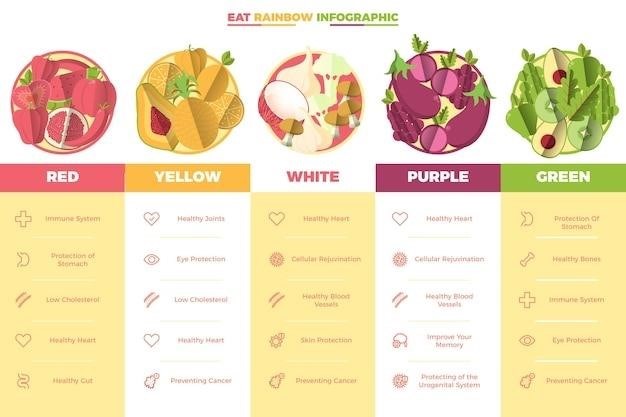
Jeûne Intermittent Menu PDF Gratuit⁚ A Comprehensive Guide
This comprehensive guide provides a detailed overview of intermittent fasting‚ exploring its various methods‚ benefits‚ and practical tips for success. It also features free downloadable PDF menus to help you seamlessly integrate intermittent fasting into your lifestyle. Discover the power of intermittent fasting and unlock its potential to enhance your well-being.
Introduction
Intermittent fasting (IF) has gained significant popularity as a flexible and effective approach to weight management and overall health improvement. It involves cycling between periods of eating and fasting‚ rather than restricting specific foods. This method allows for greater flexibility and adaptability compared to traditional diets‚ making it a more sustainable option for many individuals. The concept of intermittent fasting has been practiced for centuries in various cultures‚ but it has recently gained scientific recognition for its potential health benefits.
This guide will delve into the world of intermittent fasting‚ exploring its diverse methods‚ potential benefits‚ and practical tips for success. We will provide you with a comprehensive understanding of how intermittent fasting works‚ its various approaches‚ and how to seamlessly integrate it into your daily routine. We will also offer free downloadable PDF menus designed to support your intermittent fasting journey‚ providing you with delicious and nutritious meal options to fuel your body during your eating windows.
Whether you are seeking weight loss‚ improved metabolic health‚ or simply a more mindful approach to eating‚ this guide will empower you with the knowledge and tools to embark on your intermittent fasting adventure. Get ready to discover the power of periodic fasting and unlock its potential for a healthier and more fulfilling you.
Benefits of Intermittent Fasting
Intermittent fasting offers a range of potential health benefits that extend beyond weight loss. While more research is ongoing‚ studies have shown that IF can positively impact various aspects of health and well-being.
One of the most notable benefits of intermittent fasting is its potential for weight loss. By restricting calorie intake during fasting periods‚ it can lead to a calorie deficit‚ promoting weight reduction. Studies have shown that intermittent fasting can be as effective as traditional calorie restriction diets in promoting weight loss.
Beyond weight management‚ intermittent fasting has been linked to improvements in insulin sensitivity‚ reduced inflammation‚ and enhanced cellular repair. It can also promote autophagy‚ a cellular process that removes damaged or unnecessary cells‚ potentially contributing to longevity.
Intermittent fasting has also been associated with improved cognitive function‚ increased energy levels‚ and reduced risk of chronic diseases such as type 2 diabetes and heart disease. However‚ it is crucial to consult with a healthcare professional before starting any new dietary program‚ especially if you have underlying health conditions.
Different Methods of Intermittent Fasting
Intermittent fasting encompasses various approaches‚ each with its unique schedule and guidelines. Understanding these methods allows you to choose the one that best suits your lifestyle and preferences;
The 16/8 method‚ also known as the “time-restricted feeding” method‚ involves fasting for 16 hours daily‚ typically from dinner to lunch the next day‚ while allowing an 8-hour eating window. This method is often considered beginner-friendly and flexible for incorporating into daily routines.
The 5⁚2 method‚ also known as the “Fast Diet‚” involves restricting calorie intake to 500-600 calories for two non-consecutive days per week‚ while eating normally on the other days. This method provides a more flexible approach to intermittent fasting‚ allowing for greater dietary freedom.
Alternate-day fasting involves fasting for a full 24 hours every other day‚ with normal eating on the intervening days. This method requires a higher level of commitment and may not be suitable for everyone.
Other intermittent fasting methods include the Eat Stop Eat method‚ which involves fasting for 24 hours once or twice per week‚ and the Warrior Diet‚ which involves eating small meals during the day and a large meal in the evening.
16/8 Method
The 16/8 method‚ often referred to as “time-restricted feeding‚” is a popular and relatively easy-to-follow approach to intermittent fasting. It involves restricting your eating window to 8 hours each day while fasting for the remaining 16 hours. This method typically involves skipping breakfast and delaying your first meal until later in the day‚ often around midday.
During the 16-hour fasting period‚ you can consume calorie-free beverages such as water‚ unsweetened tea‚ or black coffee. The 16/8 method allows you to maintain a regular eating pattern‚ making it a more sustainable approach for many individuals. It can be easily incorporated into various lifestyles and doesn’t require drastic dietary changes.
The 16/8 method has gained popularity for its potential benefits‚ including weight loss‚ improved insulin sensitivity‚ reduced inflammation‚ and enhanced cognitive function. However‚ as with any dietary change‚ it’s crucial to consult with a healthcare professional before embarking on intermittent fasting‚ especially if you have any underlying health conditions.
Sample 16/8 Intermittent Fasting Menu
This sample 16/8 intermittent fasting menu provides a framework for planning your meals within an 8-hour eating window. Remember that individual needs and preferences may vary‚ so feel free to adjust the menu according to your dietary requirements and tastes.
Breakfast (Skip)⁚ During your fasting window‚ you can consume calorie-free beverages such as water‚ unsweetened tea‚ or black coffee.
Lunch (12⁚00 PM)⁚
- Grilled Chicken Salad⁚ Grilled chicken breast‚ mixed greens‚ cherry tomatoes‚ cucumber‚ avocado‚ and a light vinaigrette dressing.
- Lentil Soup⁚ A hearty and filling lentil soup with vegetables like carrots‚ celery‚ and onions.
- Veggie Wrap⁚ A whole-wheat tortilla filled with hummus‚ spinach‚ bell peppers‚ and your favorite vegetables.
Dinner (6⁚00 PM)⁚
- Salmon with Roasted Vegetables⁚ Baked salmon served with roasted asparagus‚ broccoli‚ and bell peppers.
- Chicken Stir-Fry⁚ Chicken breast stir-fried with mixed vegetables‚ ginger‚ and soy sauce.
- Tofu Scramble⁚ Scrambled tofu with onions‚ bell peppers‚ spinach‚ and spices.
Snack (Optional)⁚ If you feel hungry‚ you can have a light snack between meals. Consider⁚
- A handful of almonds or walnuts.
- A piece of fruit like an apple or banana.
- A small cup of Greek yogurt.
This is just a sample menu‚ and you can customize it to fit your individual needs. Experiment with different foods and meal combinations to find what works best for you. Remember to drink plenty of water throughout your fasting window and eating periods to stay hydrated.
The 5⁚2 Method
The 5⁚2 method‚ also known as the Fast Diet‚ is a form of intermittent fasting that involves eating normally for five days a week and restricting calories to 500-600 for women and 600-700 for men on the other two days. These fasting days are not consecutive‚ and you can choose any two days that work best for your schedule.
This approach allows for flexibility and can be easier to incorporate into your lifestyle than other methods of intermittent fasting. It’s important to note that the 5⁚2 method is not about specific foods to eat or avoid on your fasting days. Instead‚ it focuses on the total number of calories consumed.
Here are some key points to remember about the 5⁚2 method⁚
- Choose two non-consecutive days for your fasting days.
- Consume 500-600 calories for women and 600-700 calories for men on your fasting days.
- Focus on nutrient-dense foods on your fasting days‚ such as vegetables‚ lean protein‚ and whole grains.
- Ensure adequate hydration by drinking plenty of water‚ unsweetened tea‚ or black coffee during your fasting days.
- Listen to your body and adjust the calorie intake as needed. If you feel overly hungry or weak‚ increase your calorie intake slightly.
- Consult with your healthcare provider before starting the 5⁚2 method‚ especially if you have any underlying health conditions.
The 5⁚2 method can be a sustainable and flexible approach to intermittent fasting. It allows for a balanced lifestyle and can be adapted to fit individual needs and preferences. Remember to prioritize healthy food choices and stay well-hydrated during your fasting days.
Sample 5⁚2 Intermittent Fasting Menu
Here is a sample 5⁚2 intermittent fasting menu that adheres to the 500-600 calorie restriction for women on fasting days. This menu provides a balanced mix of nutrients and can be adjusted based on your individual preferences and dietary needs; Remember to consult with your healthcare provider or a registered dietitian for personalized guidance.
Breakfast (Optional)⁚
- 1 cup unsweetened green tea or black coffee
Lunch⁚
- Large salad with 4 ounces grilled chicken or fish‚ 1 cup mixed greens‚ 1/2 cup chopped vegetables‚ 1 tablespoon olive oil‚ and 1/4 cup balsamic vinegar
Dinner⁚
- 4 ounces baked salmon with 1 cup steamed broccoli and 1/2 cup quinoa
Snacks (Optional)⁚
- 1/4 cup mixed nuts or seeds
- 1 cup unsweetened almond milk
This menu provides approximately 550 calories‚ but remember to adjust the portions and food choices to fit your individual needs and calorie goals. Focus on nutrient-dense foods and prioritize hydration by drinking plenty of water‚ unsweetened tea‚ or black coffee throughout the day. Stay mindful of your hunger cues and adjust your calorie intake accordingly.
24-Hour Fasting
The 24-hour fasting method involves abstaining from all food and calorie-containing beverages for a full 24-hour period. This method is typically practiced once or twice a week and can be a more intense form of intermittent fasting. While it can be an effective way to promote weight loss‚ improve insulin sensitivity‚ and potentially enhance cellular repair‚ it’s crucial to approach it with caution and proper preparation.
The 24-hour fasting period can be structured in various ways‚ but a common approach is to fast from dinner one evening to dinner the following evening. During the fasting period‚ you can consume water‚ unsweetened tea‚ or black coffee‚ but avoid any calorie-containing beverages or food.
Before embarking on a 24-hour fast‚ it’s vital to consult with your healthcare provider‚ especially if you have any underlying health conditions. Ensure you are well-hydrated during the fasting period and break the fast gradually with light‚ easily digestible foods. Listen to your body and be mindful of potential side effects‚ such as fatigue‚ headaches‚ or dizziness. Adjust the frequency and duration of your fasts based on your individual tolerance and goals.
Sample 24-Hour Fasting Menu
While a 24-hour fast involves abstaining from all food and calorie-containing beverages‚ it’s essential to prioritize hydration and break the fast with carefully chosen meals. The following sample menu provides a framework for a 24-hour fast‚ but remember to adapt it based on your individual needs and preferences.
Fasting Period⁚
During the 24-hour fasting period‚ focus on consuming plenty of fluids like water‚ unsweetened tea‚ and black coffee. Avoid any calorie-containing beverages or food.
Breaking the Fast⁚
Start with a light and easily digestible meal. A small portion of vegetable broth or a smoothie with leafy greens‚ fruits‚ and a plant-based protein can be a good choice.
First Meal After the Fast⁚
Opt for a balanced meal that includes protein‚ healthy fats‚ and complex carbohydrates. For example‚ a salad with grilled chicken or fish‚ a bowl of lentil soup with whole-grain bread‚ or a veggie-packed stir-fry with tofu or tempeh.
Post-Fast Meals⁚
Continue to focus on nutritious‚ wholesome meals rich in fruits‚ vegetables‚ whole grains‚ and lean proteins. Listen to your body and avoid overeating after a fast.
Tips for Success
Embarking on an intermittent fasting journey requires a mindful approach and a few key strategies for success. Here are some practical tips to enhance your experience and ensure a smooth transition into this lifestyle⁚
Listen to Your Body⁚ Pay close attention to your hunger and fullness cues. Avoid forcing yourself to eat if you’re not genuinely hungry‚ and stop eating when you feel comfortably satisfied.
Hydration is Key⁚ Stay well-hydrated throughout your fasting periods by drinking plenty of water‚ unsweetened tea‚ or black coffee. Adequate hydration helps curb hunger and supports overall health.
Mindful Eating⁚ During your eating window‚ practice mindful eating. Focus on your food‚ savor each bite‚ and avoid distractions. This can help you avoid overeating and appreciate your meals more fully.
Gradual Transition⁚ If you’re new to intermittent fasting‚ start with shorter fasting periods and gradually increase them over time. This allows your body to adjust and minimizes potential side effects.
Seek Guidance⁚ Consult with a healthcare professional‚ especially if you have any underlying health conditions or are taking medications. Their guidance can help you determine if intermittent fasting is suitable for you and ensure safety.
Intermittent fasting is a flexible and adaptable approach to eating that can offer a range of potential health benefits. It’s not a diet in the traditional sense but rather a pattern of eating that allows your body to experience periods of fasting and feasting. This cyclical approach can help you manage your weight‚ improve metabolic health‚ and enhance overall well-being.
The key to success with intermittent fasting lies in finding a method that aligns with your lifestyle‚ preferences‚ and health goals. Whether you choose the 16/8 method‚ the 5⁚2 method‚ or another variation‚ consistency and mindful eating are crucial for achieving optimal results.
Remember‚ intermittent fasting is a personal journey‚ and it’s essential to listen to your body and adjust your approach as needed. With a little planning and the right mindset‚ you can unlock the potential of intermittent fasting and experience its transformative benefits.
Where to Find Free Intermittent Fasting Menu PDFs
The internet is a treasure trove of resources for those interested in intermittent fasting‚ and free downloadable PDFs are readily available. To find these valuable guides‚ start by searching for keywords like “intermittent fasting menu PDF‚” “free intermittent fasting meal plans‚” or “16/8 intermittent fasting PDF.” You’ll likely discover a wealth of options from reputable sources‚ including health and wellness websites‚ blogs‚ and even fitness apps.
When exploring these resources‚ look for PDFs that provide detailed menus with specific recipes‚ nutritional information‚ and practical tips for success. It’s also helpful to consider the experience and credibility of the source. Ensure the author or website has a strong background in nutrition‚ health‚ or fitness to ensure the accuracy and reliability of the information provided.
Don’t hesitate to explore different PDFs to find the one that best suits your individual needs and preferences. Remember‚ the goal is to find a resource that inspires and empowers you to embrace the benefits of intermittent fasting with ease and confidence.




